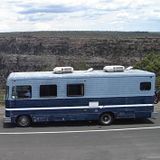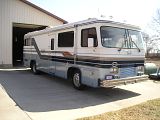Go to...  | Start A New Topic  | Search  | Notify  | Tools  | Reply To This Topic  |  |
 |
Has this ever happened to you??? >> http://www.youtube.com/watch?v=8wODPrH5qtY _________________________ The 82 MCC {by Barth} is not an rv-- it is a Motor Coach!! | ||
|
| First Month Member |
Makes me glad I put Tyrons up front. . 84 30T PeeThirty-Something, 502 powered | |||
|
"Host" of Barthmobile.com 1/19 1/19 |
| |||||||||||||||
| ||||||||||||||||
 4/10 4/10 |
This video actually demonstrates a second example of keeping your rig under control but doesn't specifically point it out. What I'm referring to is air pressure (or truck wash) that is created when a large rig passes you at a higher rate of speed than you're traveling and the force of that air pushes you perpendicular (out of the center of your lane) to your forward movement. If you anticipate the "truck wash" and accelerate you will reinforce your forward momentum and not be pushed out of your lane position as the truck passes you. You would use the same technique passing out from under an overpass on a windy day, accelerate as you exit under the bridge so that the wind gust doesn't push you out of your lane. I'm only mentioning this because I see a lot of RV's blown out of their lane by passing trucks and in a high traffic situation they're obviously not aware of the accelerating technique, and by not using the advice in the video in any of these situations (tire, truck wash, or wind gusts) it could very easily result in a fatal accident. Didn't intend to hijack the thread, I'll get off my soap box now. Thanks for the link to the video. 1990 32' Regency Spartan Chassis Cummins CTA8.3 Allison 4 speed | |||
|
 |
Doug, thanks for the greatly informative link. Bill H, what is a Tyron? Blow outs from road hazards go with the territory. Blow outs from tire age and history are avoidable. I was advised to get new tires by the members here, and I was glad I did. The tires looked new. However, the date code of 459 means they were produced in the 45th week of the 9th year. Since it isn't the 45th week of 2009 yet, that means either 1999 or 1989. The tires are Goodyear G159. That model on the 22.5 inch rim has been observed to have many unexpected blowouts, and the stories I read are that RV manufacturers would pressurized the tire to 30 psi, and later the dealerships would set them to full pressure. In the meantime, the tire was enduring a stress condition in a fixed position for weeks or years. The new owner wouldn't know this, and blammo. I've got 19.5 inch rims, yet I do not know the service history of the tires. Obviously they have been installed and unused for years. And even if they are pressurized properly, the tire was not designed to undergo months of inactivity. Parts of the sidewall are at risk of delamination apparently. So, I got new tires. And to assist with the road hazard oriented blowout, I also installed the Safe-T-Plus steering stabilizer. [should I be concerned that the Safe-T-Plus is making the hydroboost pump work harder?] Matt 1987 Barth 27' P32 Chassis Former State Police Command Post Chevrolet 454 Weiand Manifold, Crane Cam, Gibson Exhaust | |||
|
| First Month Member |
A metal band that clamps around the center of the wheel to cover the depression. This does not keep the tire from becoming unseated in a blowout, but it does keep it in place on the full diameter of the rim instead of going all over the place. It is used extensively by police and military. One of my sons had experience with them in combat in Afghanistan, and has experienced shot-out tires with and without. He says with is better. http://www.google.com/search?h...yre+band&btnG=Search
Yes. You've hit on one of my cranks. I believe that tires last way longer when used. Sitting is at least as bad as driving under-inflated. My Barth goes for a 20-mile ride every week and genset and air conditioners or heat strips run every other week. Even the water pump runs with the bypass partially open during the ride. Tires not only do not like sitting with the sidewalls stressed in one spot, but need flexing and heating to "bloom" the preservative chemicals from the inside to the outside. There are those who say put nothing on your sidewalls, but I use Goodrich Age Master. It is a product to preserve rubber de icer boots on airplanes. I know of no worse conditions for rubber than de icer boots. My ongoing experience with British cars has also convinced me of its worth.
No. Your pump works harder in slow, tight maneuvering and parking than it does going down the road with a safe T plus or Steer Safe. BTW, blowout safety on the front an IFS vehicle is also enhanced by a heavier anti-sway bar in front. In addition to adding general stability, when one side drops from the blowout, the suddenness of the lean will be lessened, and the opposite side will be forced to "kneel" more by the heavier bar, making the whole experience less dramatic and more controllable. . 84 30T PeeThirty-Something, 502 powered | |||
|
 10/10 10/10 |
Many thanks for the great video on blowouts and the tips for handling a motorhome under varying driving conditions. I didn't know any of these driving techniques before today. With regard to tire age. The almost new old Barth (1993) that I just bought received a brand new set of tires because the ones on it were 1993 vintage. The old ones looked good but it's clear they needed to be changed. I'm sure they would be good for farm rigs or other application where they aren't subjected to high speeds and heat. My brother is supposed to be checking with local farmers to see if any of them could use them. Do you guys have any other ideas where they could be used safely? Roman 1993, 34', Regency, Widebody 300 HP Cummins 6 spd Allison, Spartan Chassis | |||
|
| First Month Member |
Construction equipment that didn't go fast on the road. At the airport, our jetways used un-recappable airliner tires. . 84 30T PeeThirty-Something, 502 powered | |||
|
| Powered by Social Strata |
| Please Wait. Your request is being processed... |
|
This website is dedicated to the Barth Custom Coach, their owners and those who admire this American made, quality crafted, motor coach.
We are committed to the history, preservation and restoration of the Barth Custom Coach.
We are committed to the history, preservation and restoration of the Barth Custom Coach.



